Complete Solutions to Examples of chapter THERMAL AND ELECTRIC EFFECT oF CURRENT of Class 12 book with complete answers and questions
| Class 12 | PHYSICS |
| Chapter | THERMAL AND ELECTRIC EFFECT oF CURRENT |
| CP SINGH | Examples |
| Number Of Questions | 41 |
| Academic Year | 2023-24 |
(a) Two heater coils made of the same material are connected in paralled across the mains. The length of diameter of one the coil is triple that of other. Which of these will produce more heat?
(b) Three equal resistors connected in series across a source of emf together dissipated `10 Watt` of power. What would be the power disspated if the same resistors are connected in parallel across the same source of emf?
Two resistor `R_(1)` and `R_(2)` may be connect either in series or in parellel across a battery of zero internal resistance. it is required that joule heating for the parallel combination be four times than for series combination. if `R_(1)= 100 Omega` find `R_(2)`
(d) The three resistance `A, B and C` have values `3R, 6R` and `R` respectively. Now some potential difference is applied across the network . Find the ratio of thermal powers dissipated between `X` and `Y` . find ratio of power consumed by `A,B, and C`.
 15:03View Solution
15:03View Solution(a) When a cell sends current through a resistance `R_(1)` for time `t`, the heat produced in the resistor is `Q`. When the same cell sends current through another resistance `R_(2)` for time `t` the heat porduced is again `Q` . Find internal resistance of the cell.
(b) An electric kettle has coil `A` is swithched on, the water boils in 10min. and when coil b is switched on the water boils in `20min`. Calculate the time taken by the water to boil if the coils connected in (i) series and (ii) parallel are swithched on.
(c) The emf of battery `E` in the circuit shown in the figure is 15V and internal resistance `0.5ohm` (i) What is the current drown from the battery? (ii) How much power is consumed in `6 ohm` resistance?
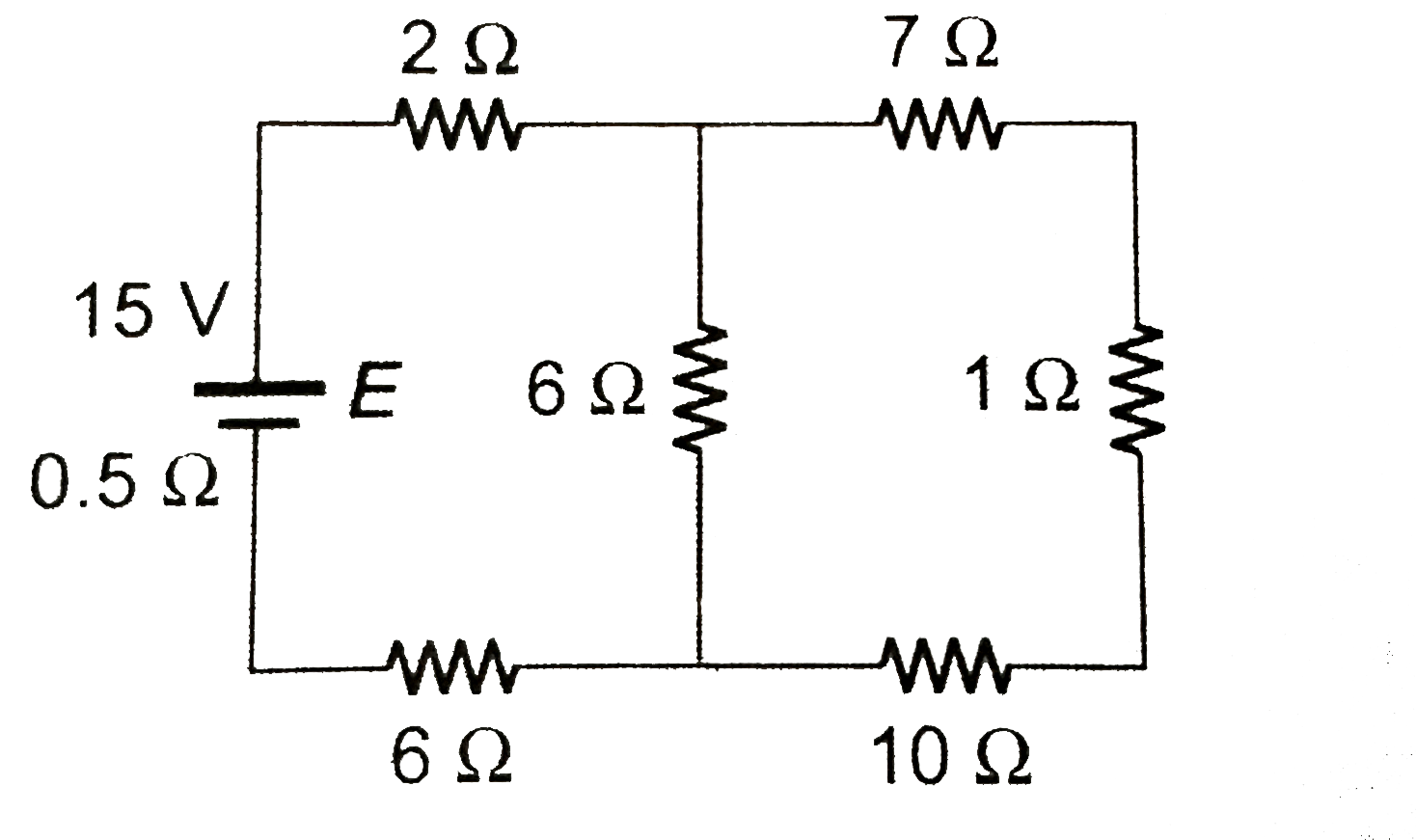
(d) A `500W` heating unit is designed to opreate from a `115V` line.
(i) By what percentage will its heat output drop if the line voltage drops to `110V`. Assuming no change in resistance?
(ii) Taking variation of resistance with temperature into account. would the actual heat output drop be larger or smaller than case(i)
(e) If emf of the cell is `1.8V` and its internal resistance `2//3 Omega` for the circuit shown in the figure what is the (i) current in `3 ohm` resistance? (ii) Power consumed by the circuit from the battery?
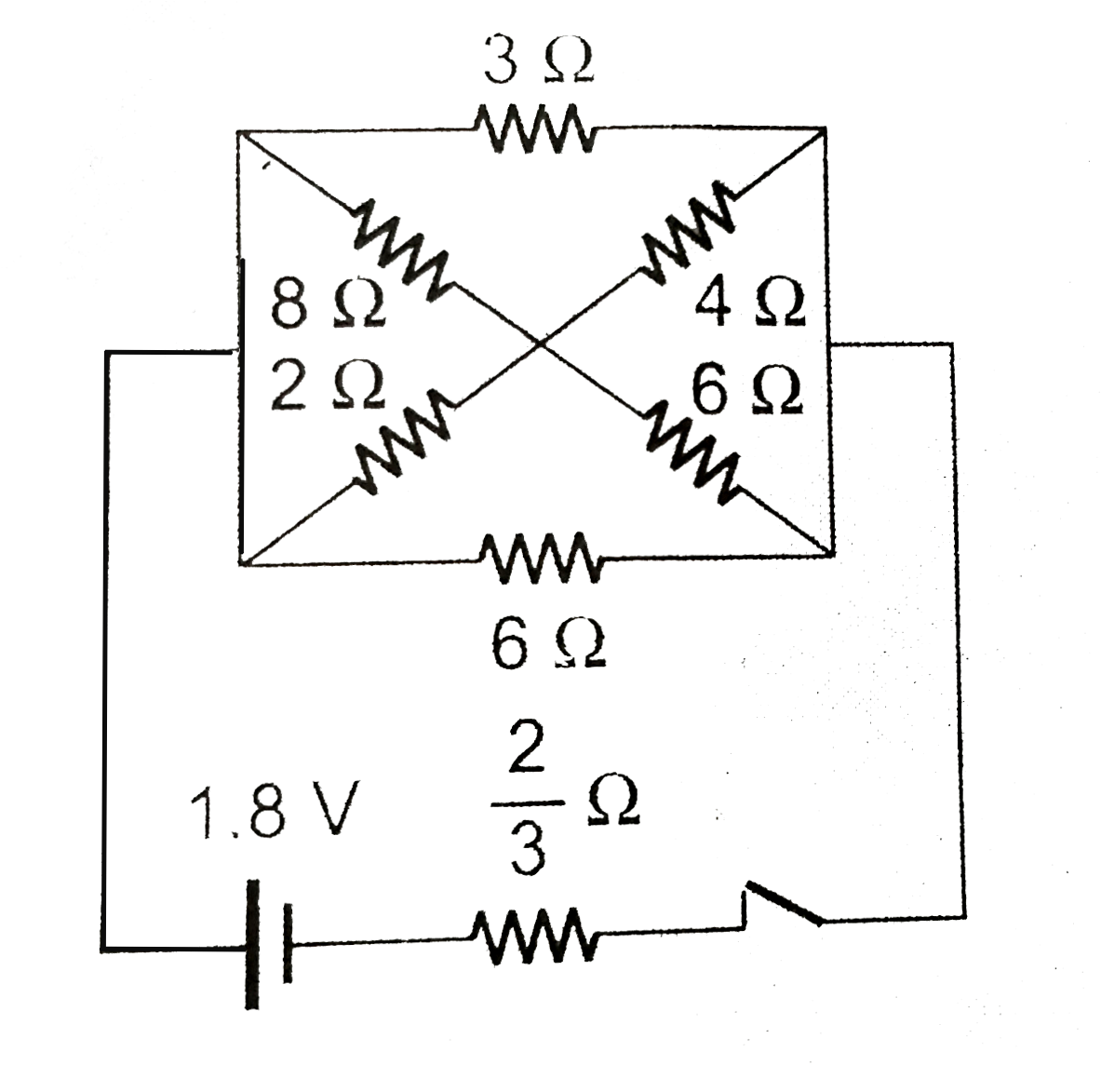
(i) for what value of `R` , power in `R` is maximum?
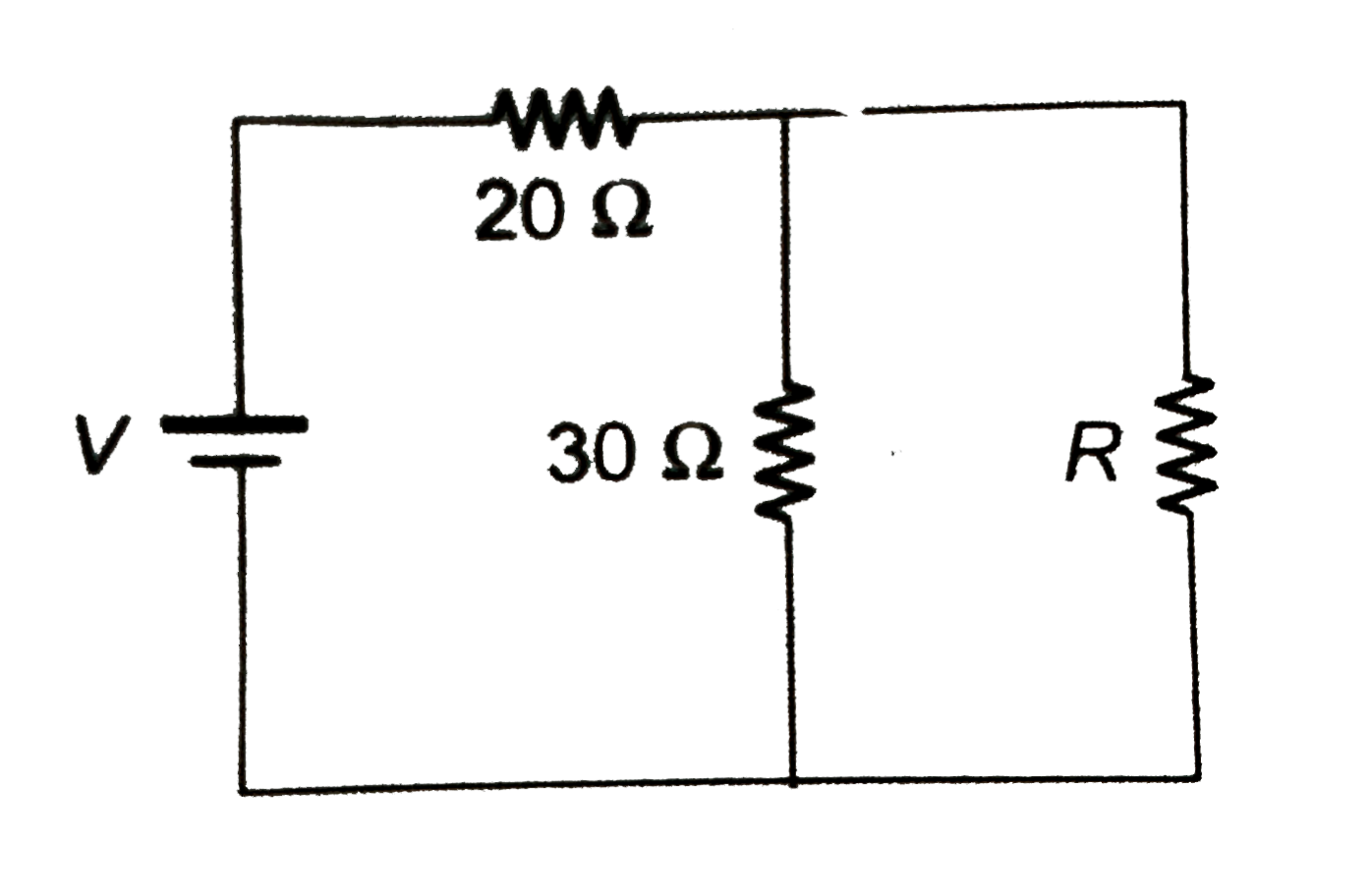 .30:01View Solution
.30:01View Solution(a) A cell of emf `E` and internal resistance `r` is connected to a resistance `R`.
(i) Relate `r` and `R`, so that power in `R` is maximum.
(ii) Maximum power consumed by `R`.
(iii) Efficiency.
(b) Find value `r` in terms of `R` so that power in external circuit is maximum.

(c) A battery of internal resistance `4Omega` is connected to the network of resistance as shown in the figure. what must be the value of `R` so that maximum power is delivered to the network? what is tha maximum power?
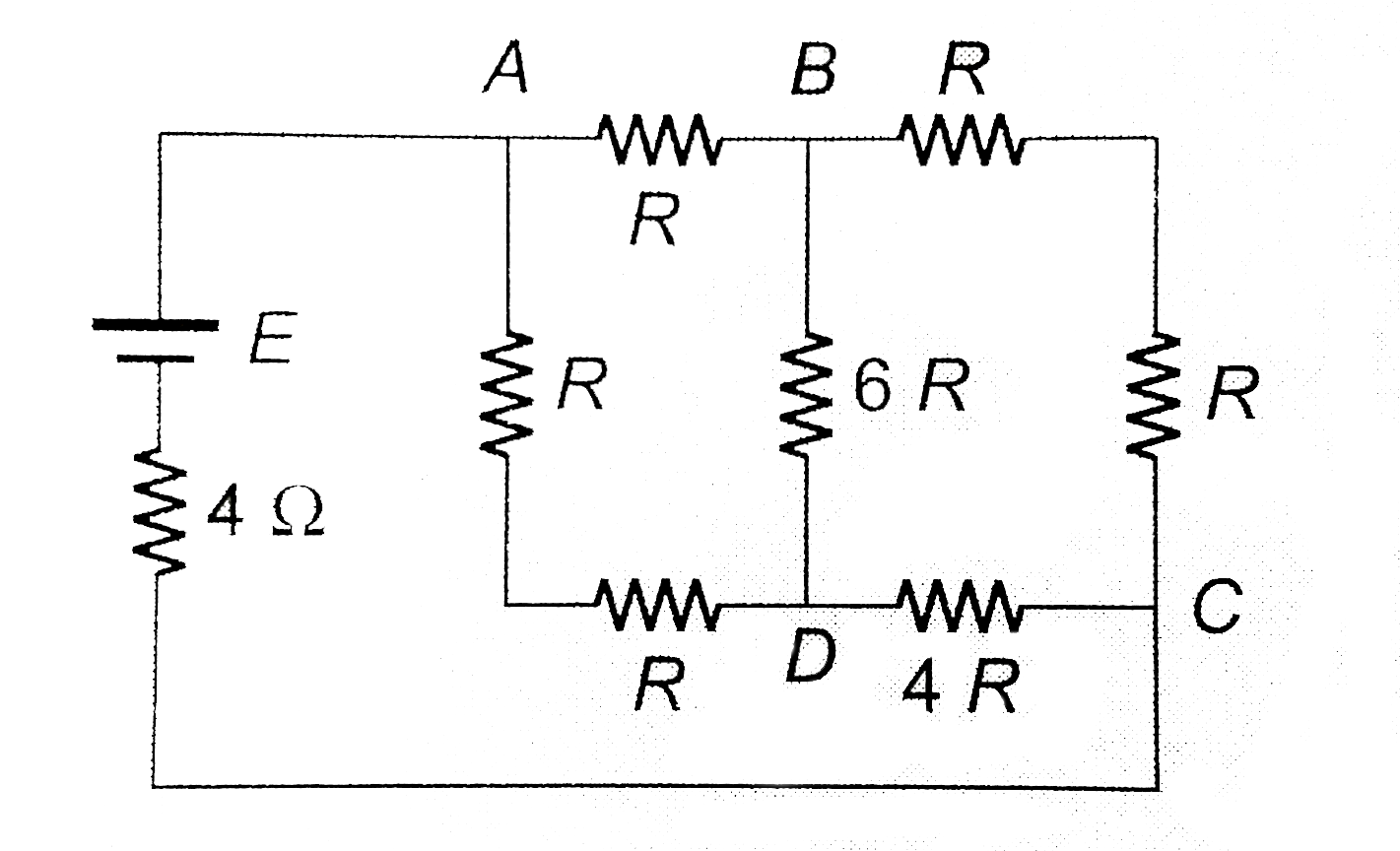 10:38View Solution
10:38View Solution(a) A `220V-100W` bulb is connected to `110V` source. Calculate the power consumed by the blub.
(b) Calculate the following for a `100W - 200V` bulb
(i) Resistance of the filament of bulb
(ii) Current through bulb when it is connected to `200V` line
(iii) Power consumed when bulb is connected to `100V` line
(c) An electric bulb rated `100W -200V` is used in a circuit having `400V` supply. what resistance `R` must be put in series with bulb so that bulb delivers `100W`?
(d) Repeat the previous problem, if bulb delivers `25W`.
(e) Two bulbs, `50W-220V, 100W-200V` are connected in series across a `220V` supply. find the power consumed by each bulb.11:20View SolutionThree `100W, 150V` lamps are connected across a `150V power line as shown. Find (a) Voltage across each lamp and (b) total power dissipated in three bulbs.
 03:56View Solution
03:56View SolutionA series circuit consists of three bulbs connected to a battery as shown. When switch `S` is closed, what happens to (a) Power consumed in bulb `X` and `Y` (b) Power consumed in bulb `Z` (c ) the current in the circuit (d) the voltage drop across three bulbs and (e) the power consumed in circuit?
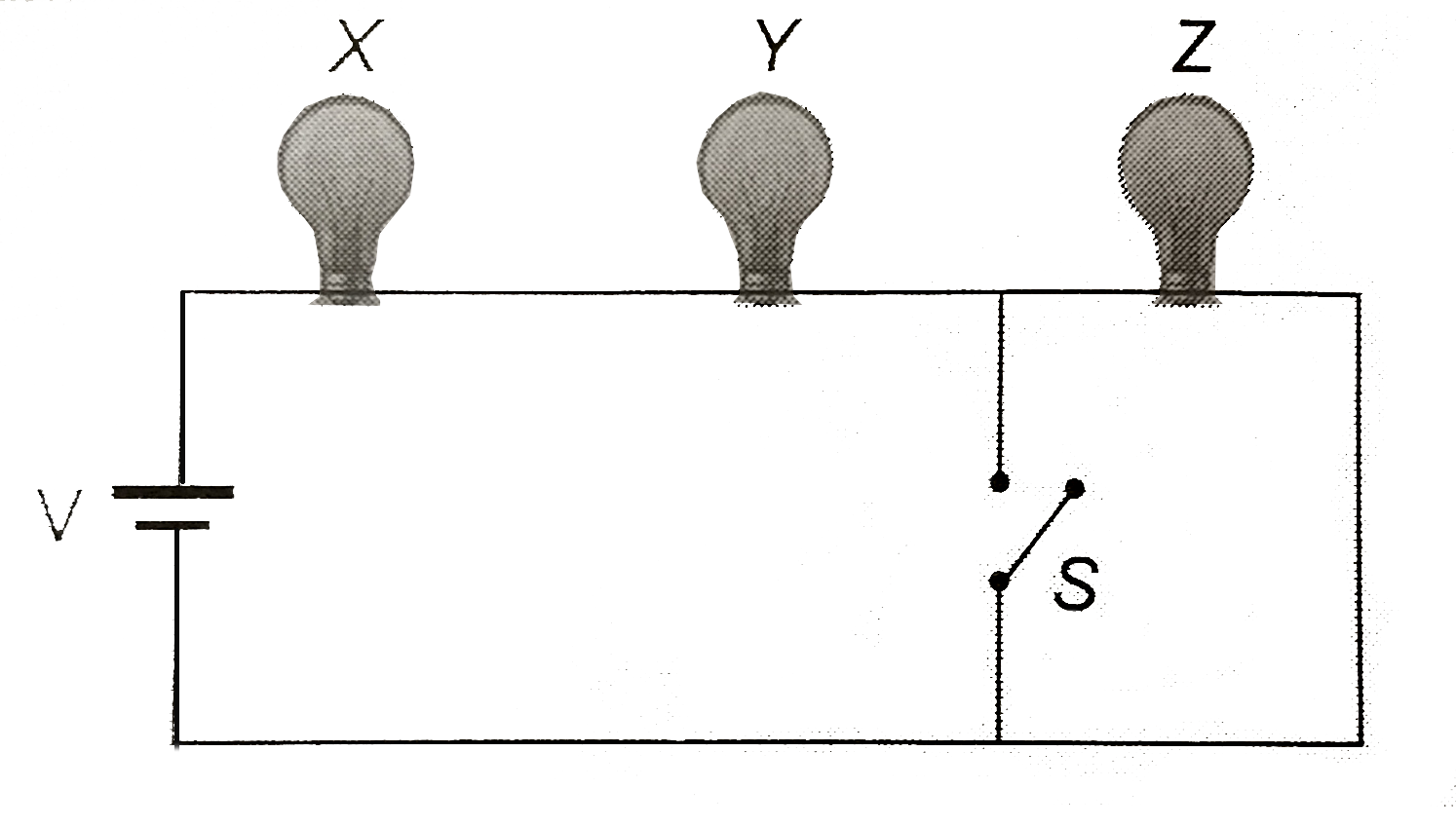 06:19View Solution
06:19View Solution(a) A `220V-100W` bulb is connected to `110V` source. Calculate the power consumed by the blub.
(b) Calculate the following for a `100W - 200V` bulb
(i) Resistance of the filament of bulb
(ii) Current through bulb when it is connected to `200V` line
(iii) Power consumed when bulb is connected to `100V` line
(c) An electric bulb rated `100W -200V` is used in a circuit having `400V` supply. what resistance `R` must be put in series with bulb so that bulb delivers `100W`?
(d) Repeat the previous problem, if bulb delivers `25W`.
(e) Two bulbs, `50W-220V, 100W-200V` are connected in series across a `220V` supply. find the power consumed by each bulb.11:20View SolutionA heater is designed to operate with a power of `1000W` in a `100 V` line. It is connected in combination with a resistance of `10 Omega` and a resistance `R`, to a `100 V` mains as shown in figure. What will be the value of `R` so that the heater operates with a power of `62.5W`?
 05:27View Solution
05:27View SolutionTwo fuse wires are made of the same material . The radius of first and second wires are `r_(1) = 2mm` and `r_(2)= 4mm`. The first wire blows when a current of `15A` passes through it. Find the current required to blow the second wire.
02:58View SolutionAn electrically heating coil was placed in a calorimeter containing `360g` of water at `10^(@)C`. The coil consumes energy at the rate of `70W`. The water equivalent of calorimeter and coil is `40g` . Find temperature of the water after `10min`. Given specific heat of water = `1 cal//g.^(@)C, 1 cal = 4.2J`.
03:47View SolutionA copper wire having area of cross section `0.4mm^(2)` and a length of 10 cm is initially at `75^(@)C` and is thermally insulated from the surroundings. If a current of `10A` is set up in this wire. ltbr. (a) Find the time in which the wire will strat melting. ignore variation of resistance with temperature.
(b) If length of wire is doubled, find time.
Given for copper : density =`10^(4) kg//m^(3)`, specific heat = `9xx10^(-2) kcal kg^(-1)(.^@C)^(-1)`, melting point =`1075^(@)C`, resispectively `=1.6xx10^(-8)Omega * m`.06:50View SolutionConsider the following arrangement of resistors .
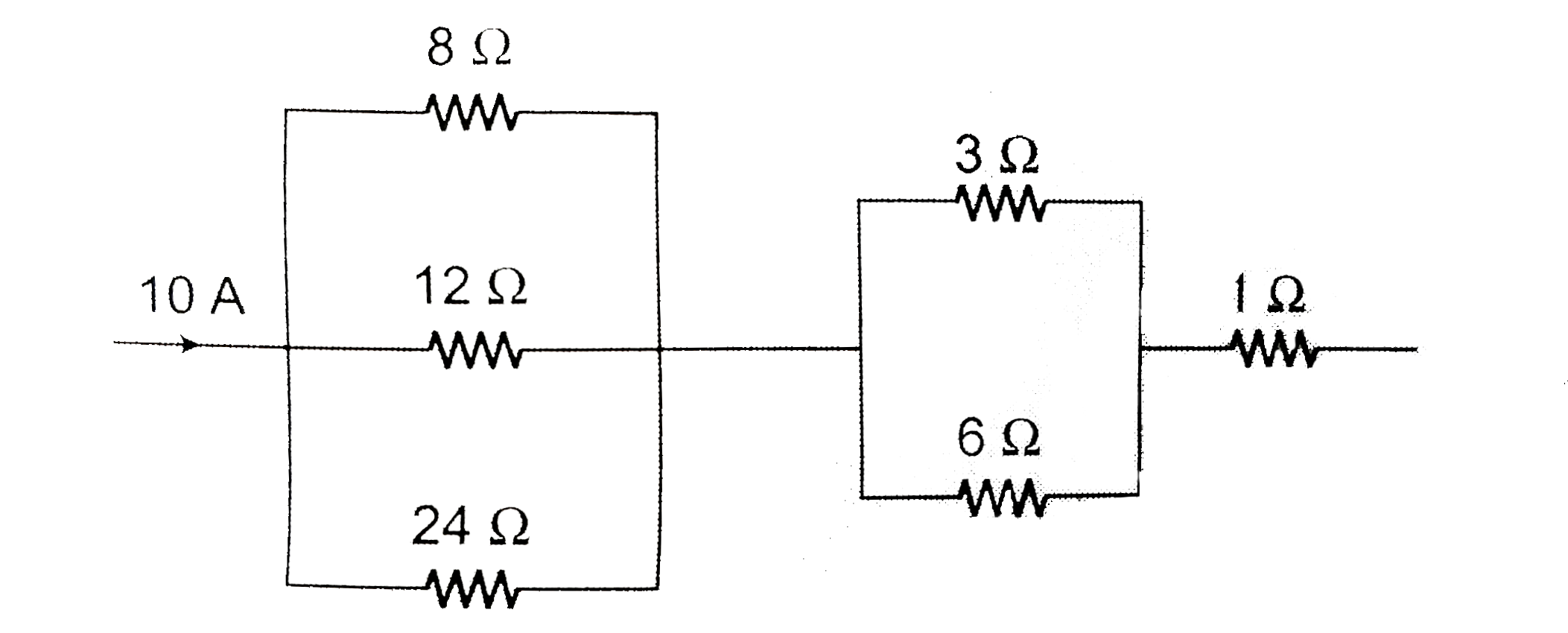
This arrangement is immersed in a box containting ice at `0^@)C` . How much ice must be put in the box constant? (Latent heat of ice `L = 80 cal//g`) .03:58View SolutionThe walls of a closed cubical box of edge `50cm` are made of a material of thickness `1mm` and thermal conductivity `4xx10^(-4) cm^(-1)(.^@C)^(-1)`. The interior of the box is maintained `100^(@)C` above the outside temperature by a heater placed inside the box and connected across `420V` d.c. calculate the resistance of copper.
05:54View SolutionThe cold junction of a thermocouple is maintained at `15^(@)C`. No thermo-emf is developed when the hot junction is mainted at `525^(@)C` . Find neutral temperature.
01:51View SolutionThe junction of a `Ni-Cu` thermocouple is maintained to `0^(@)C` and `100^(@)C`. Find the thermo-emf produced. Also, find nautral temperature and inversion temperature. Given `a_(Ni, Cu) = 16.3xx10^(-6)V//.^(@)C, b_(Ni,Cu) = -0.042xx10^(-6)V//(@C)^(2)`.
03:14View Solution(a) Electroplating unit plates `3.0g` of silver on a brass plate in 3.0min. Find the current used by the unit. The electrochemical equivalent of silver is `1.12xx10^(-6)kg//C`.
(b) Find the amount of silver liberated at cathode if `0.05A` of current is passed through `AgNO_(3)` electrolyte for `1hr`. Atomic weight of silver is `108g//"mole"`.05:08View SolutionHow long a current of 3amp has to be passed through a solution of `AgNO_3` to coat a metal surface of `80cm^(2)` with `0.005mm` thick layer. Density of silver is `10g//cm^(3)` and atomic weight = `108g//"mole"`.
02:55View SolutionThe potential difference across the terminals of a battery of `emf 12 V` and internal resistance `2 Omega` drops to `10 V` when it is connected to a silver voltameter. Find the silver deposited at the cathode in half an hour. Atomic weight of silver is `107.9 g mol^(-1)`.
03:05View SolutionFigure, shows an electrolyte of `AgCI` through which a current is passed. It is observed that `2.68g` of silver is deposited in 10 minutes on the cathode. Find the heat developed in the `20 Omega` resistor during this period. Atomic weight of silver is `107.9 g mol^(-1)`. (Figure)
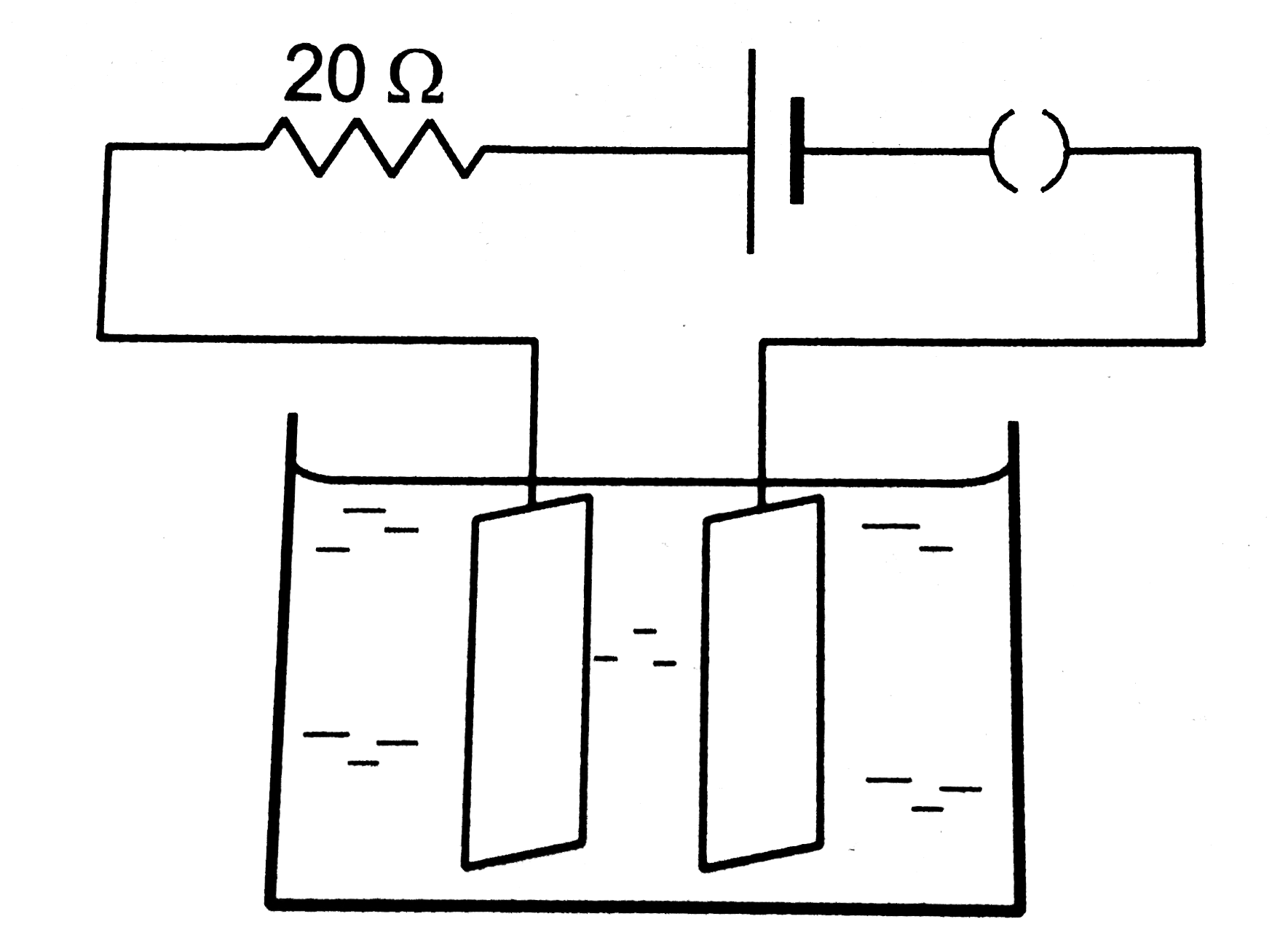 02:54View Solution
02:54View SolutionA plate of area `10 cm^2` is to be electroplated with copper `(density 9000 kg m^(-3))` to a thickness of 10 micrometres on both sides, using a cell of `12 V`. Calculate the energy spend by the cell in the process of deposition. If this energy is used to heat `100 g` of water, calculate the rise in the temperature of the water. ECE of copper `= 3 xx 10^(-7) kg C^(-1)` and specific heat capacity of water `= 4200 J kg^(-1) K^(-1)`.
06:03View SolutionFind the time requried to liberate 1.0 litre of hydrogen at STP in an electrolytic cell by a current of `5.0 A`.
02:34View SolutionTwo voltameters, one having a solution of silver salt and the other of a trivalent-metal salt, are connected in series and a current of `2 A` is maintained for `1.50 hours`. It is found that `1.00 g` of the trivalent metal is deposited. (a) What is the atomic weight of the trivalent metal? (b) How much silver is deposited during this period?
Atomic weight of silver is `109.9 g mol^(-1)`05:08View SolutionA current of `1 A` is passed through a dilute solution of sulphuric acid for some time to liberate `1 g` of oxygen. How much hydrogen is liberated during this period? How long was the current passed? Faraday constant `= 96500 C mol^(-1)`.
04:46View SolutionFind charge on capacitors in the following cases.
(a)
(b)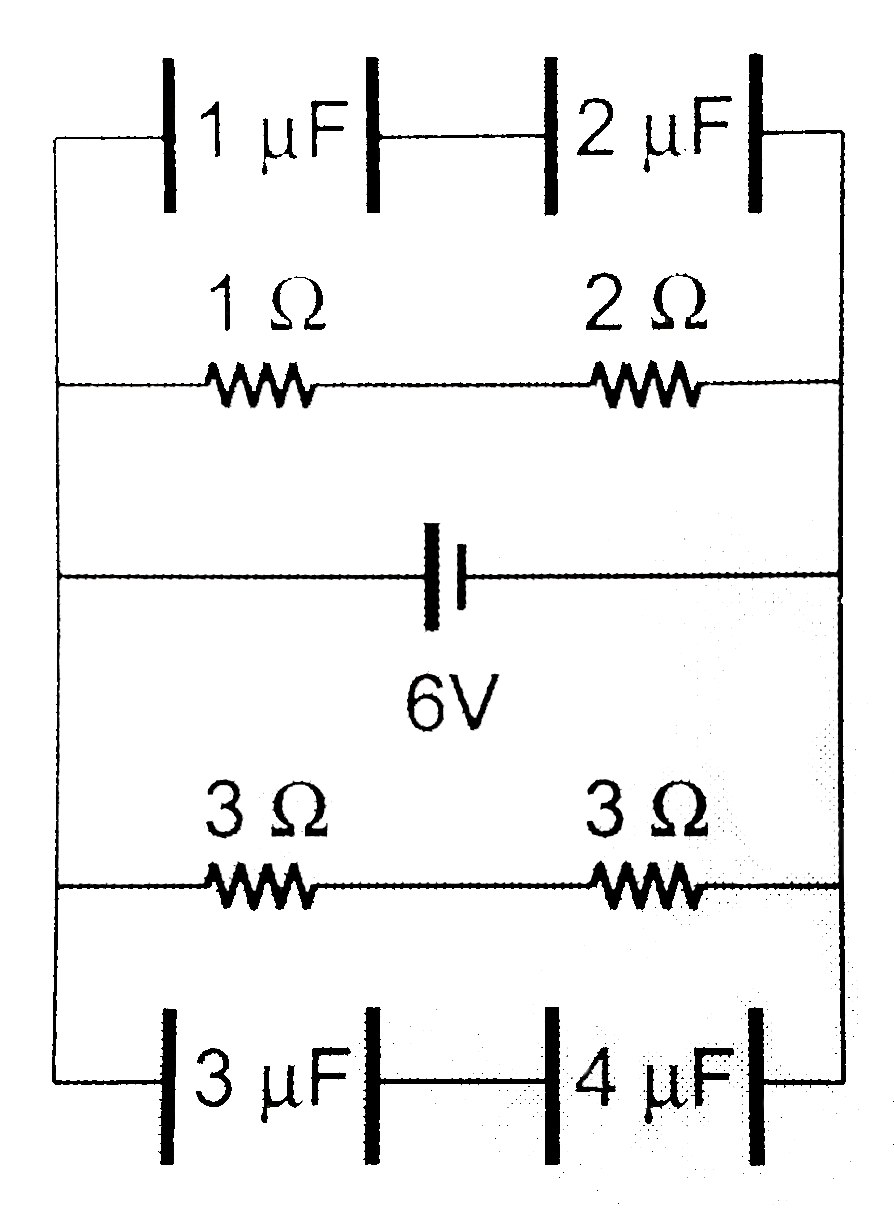
(c )
(d) 08:02View Solution
08:02View Solution(a) Find charge on capacitors
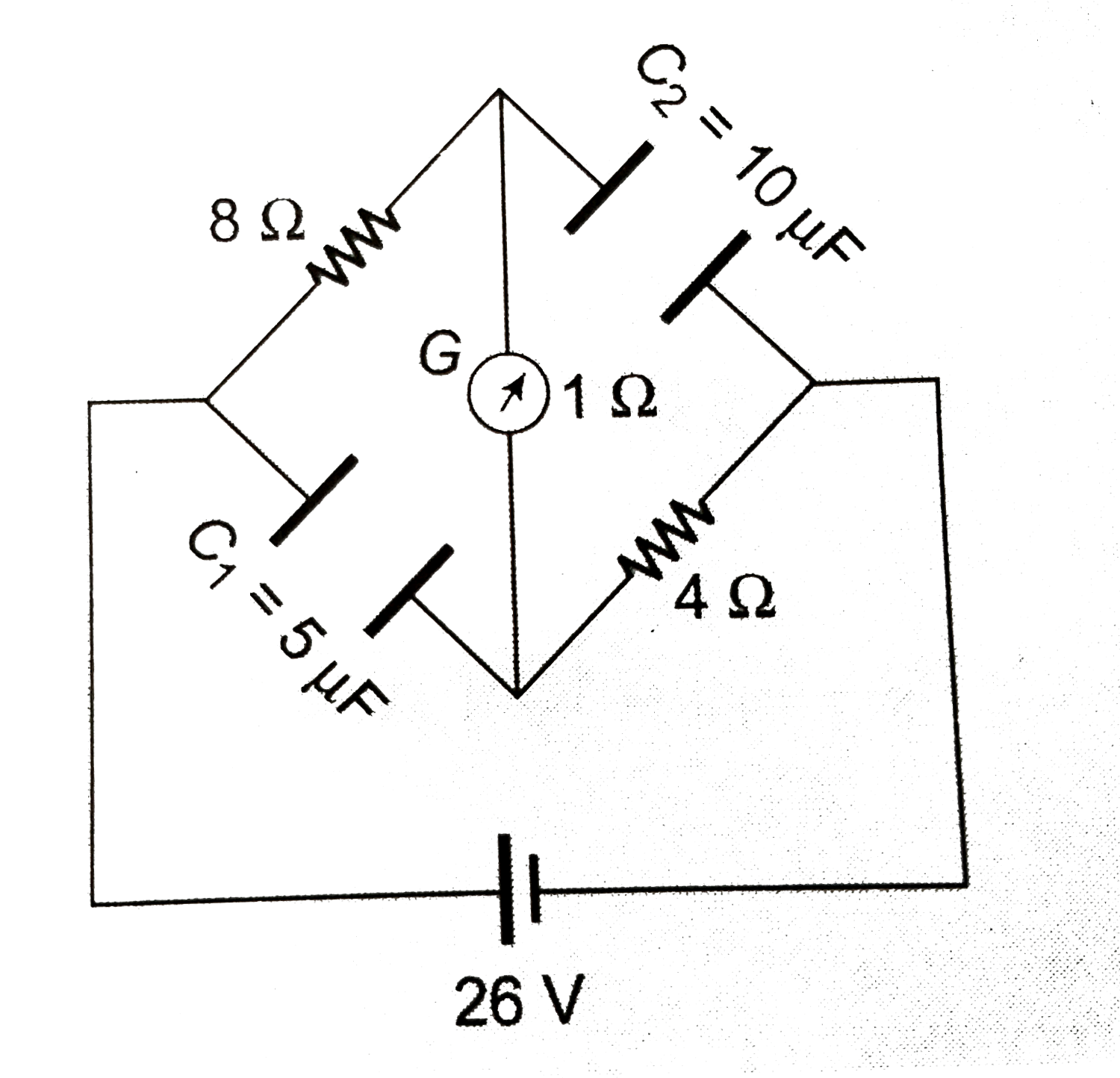
(b) Find charge on capacitor

(c ) Find energy stored in capacitor.
 12:18View Solution
12:18View Solution(a) Find potential difference between `A` and `B` and `C`.

(b) Find potential difference across capacitor `C`.


(i) Find ratio of energy stored in capacitors, `C_(1)` and `(C_2)`
(ii) If battery of emf of `2E` is short -circuited, find charge flown in battery of emf `4E`.14:53View SolutionIn the shown network, find the charges on capacitors of capacitances `5muF` and `3muF`, in steady state.
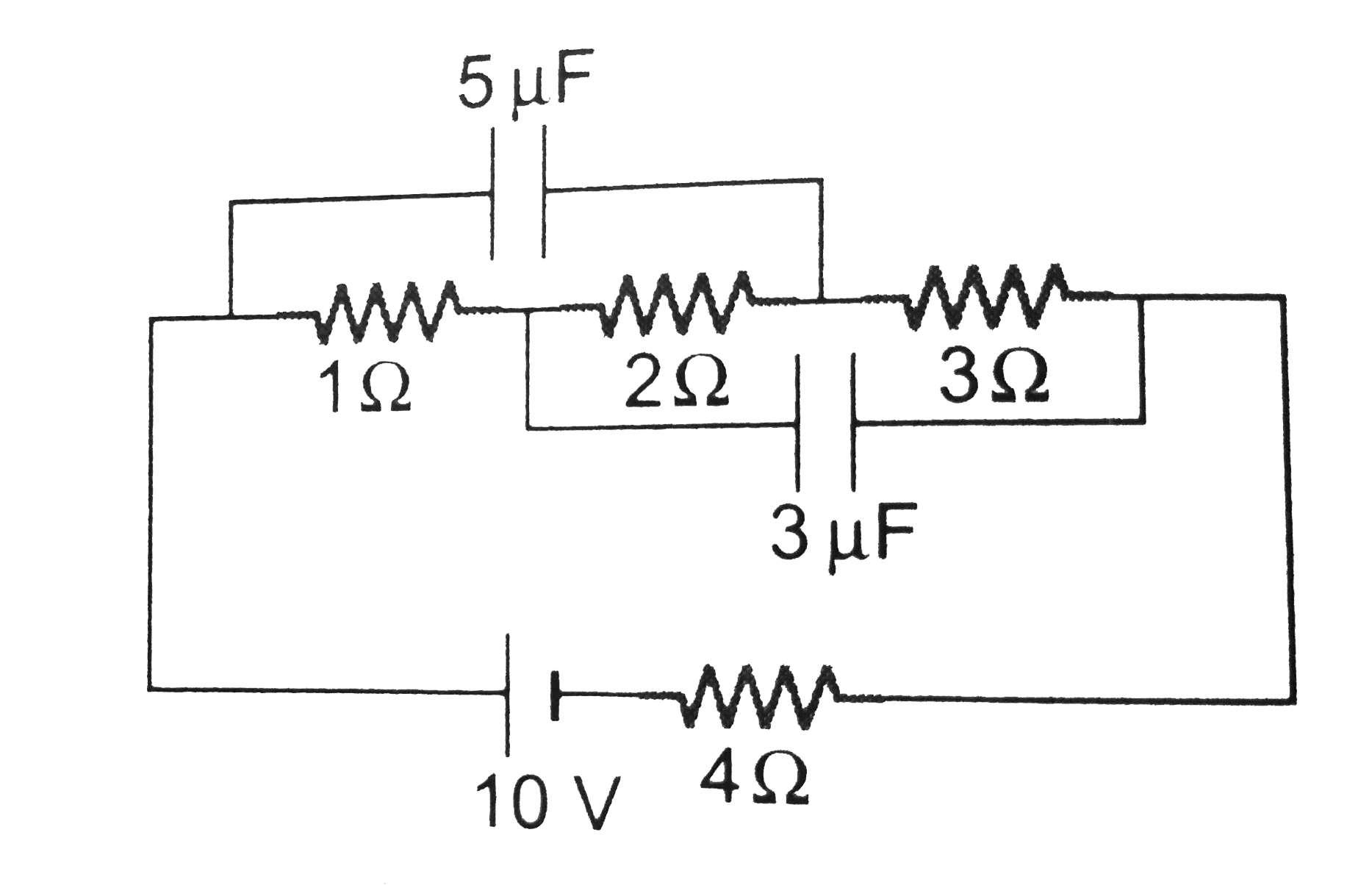 02:21View Solution
02:21View SolutionAnalyze the given circuit in the steady state condition. Charge on the capacitor is`q_0=16muC`

(a) Find the current in each branch
(b) Find the emf of the battery.
(c) If now the battery is removed and the points `A` and `C` are shorted. Find the time during which charge on the capacitor becomes
`8muC`06:54View SolutionAs shown circuit in steady state. If charge on capacitor is `1000 muC` , find (a) battery current, (b) `R_(1),R_(2), R_(3)`. The current in `50Omega` resistor and `R_(2) is `5A`.
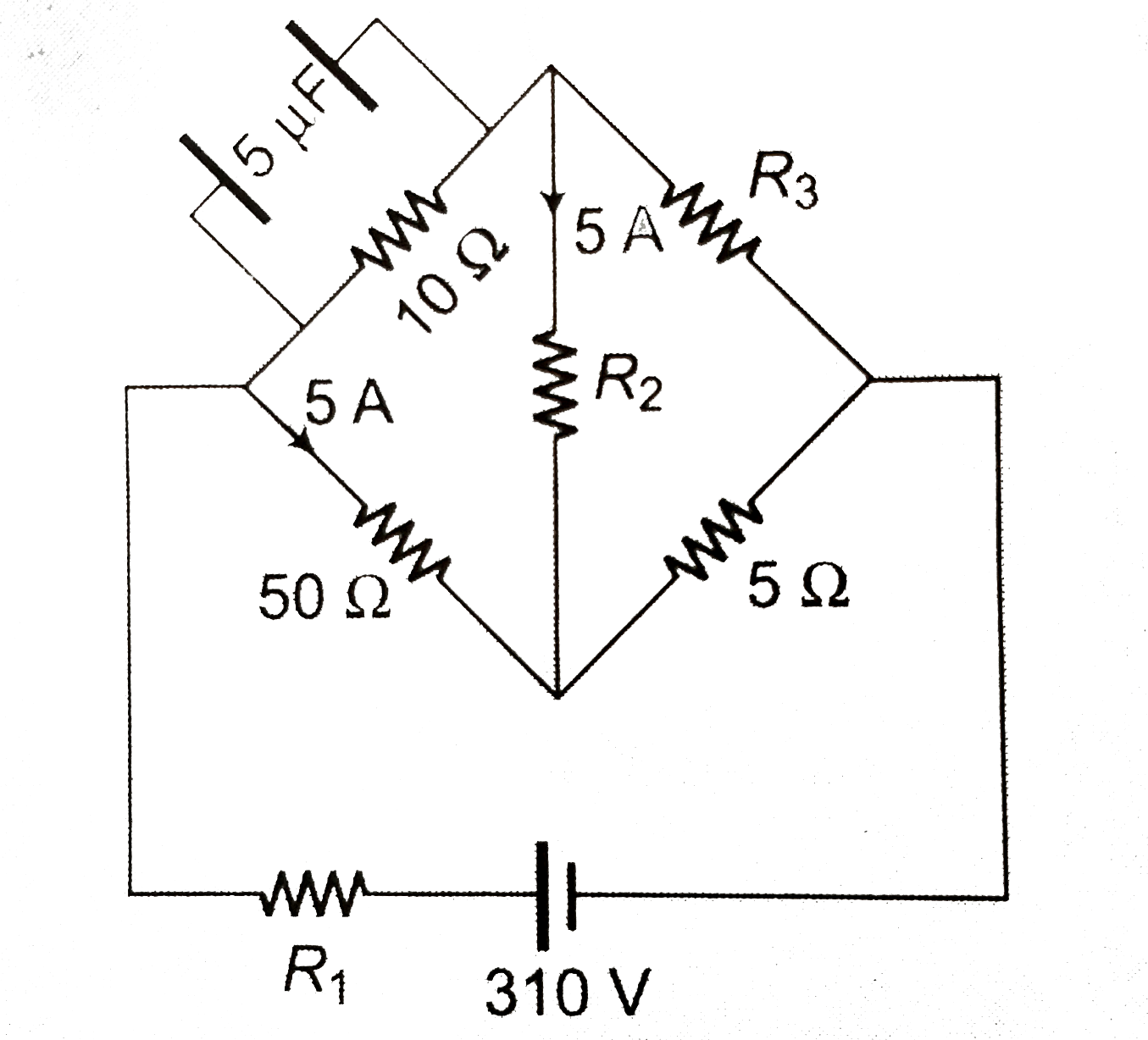 09:07View Solution
09:07View SolutionFind the potential difference between the plates of the capactior C in the circuit shown in fig.5.236
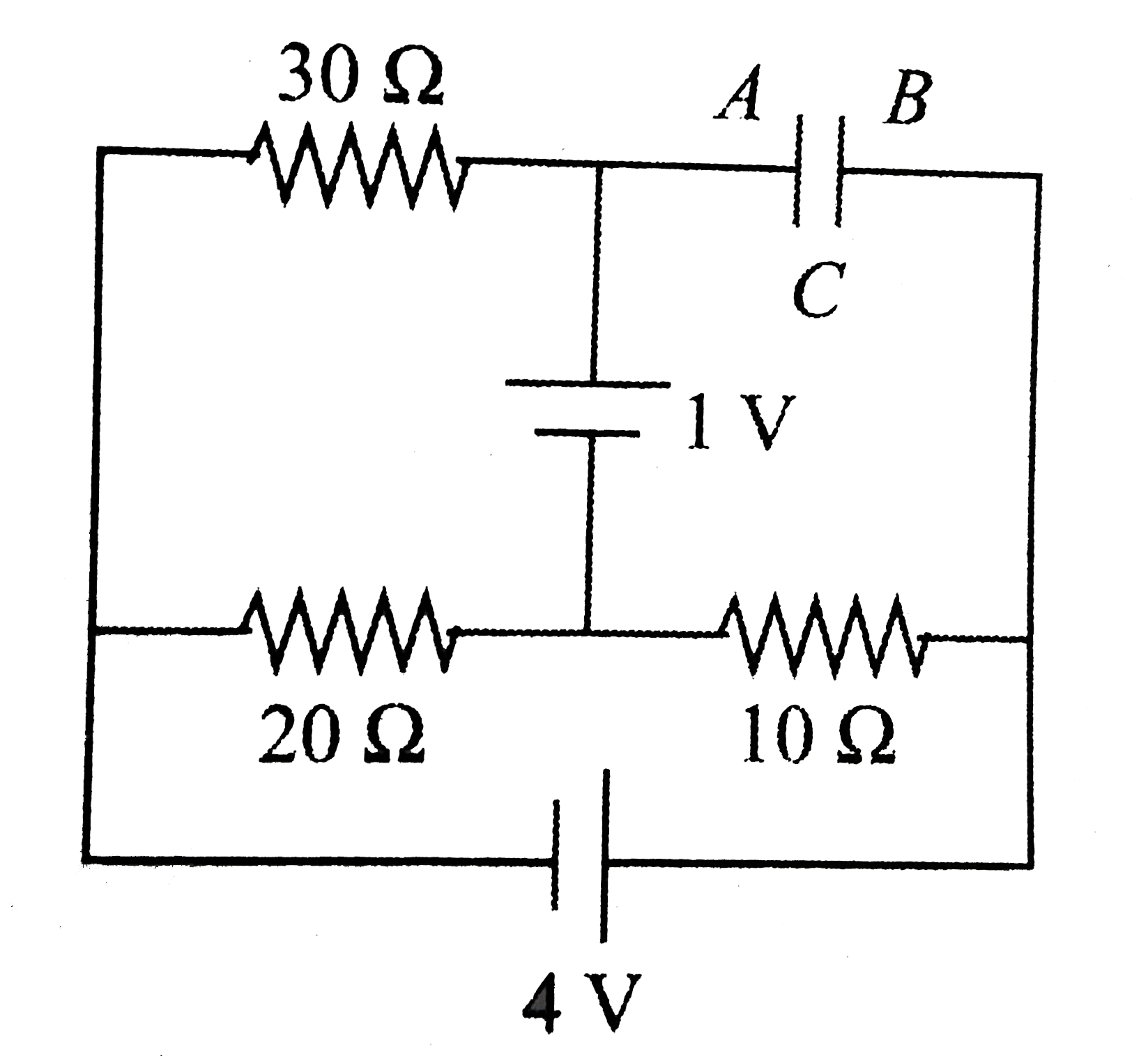 06:12View Solution
06:12View Solutionfind
(a) the current in `3Omega` resistance
(b) the change on the capacitor
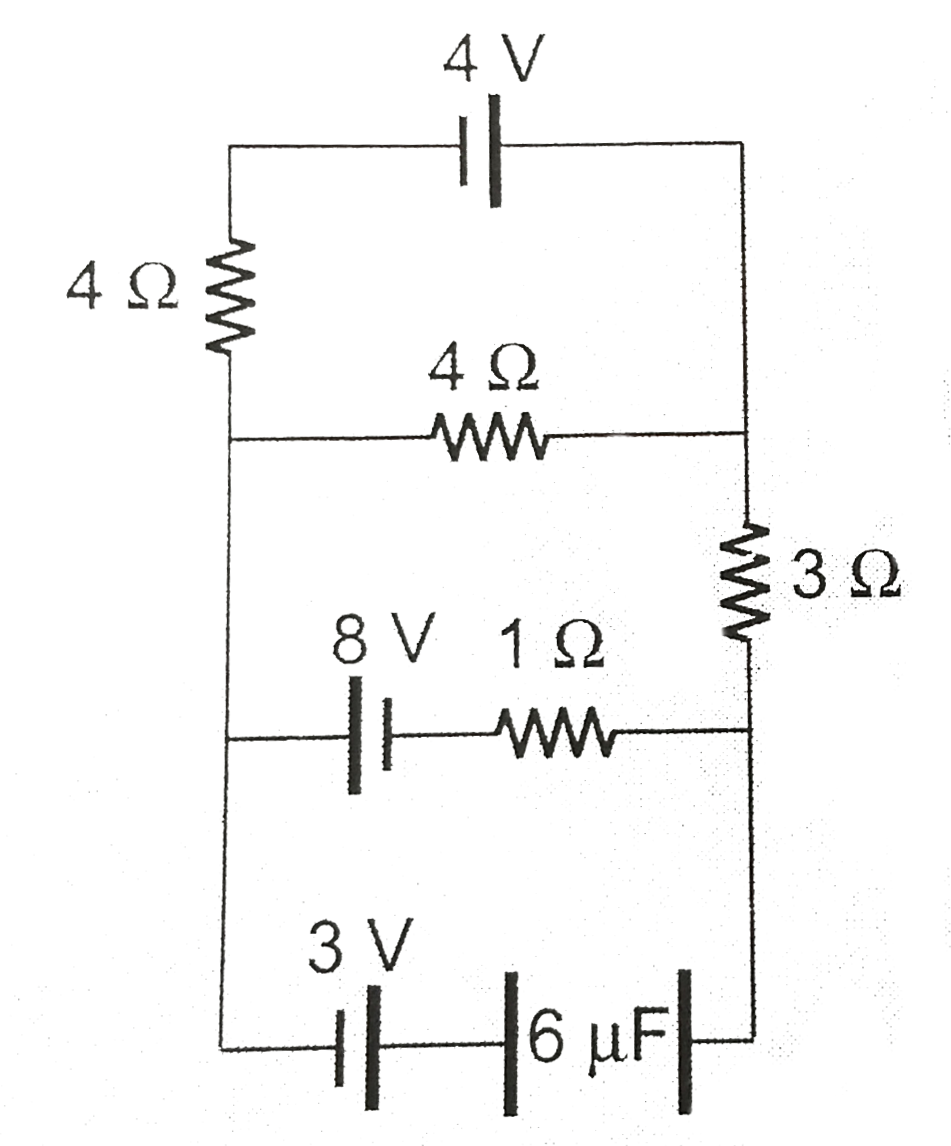 06:28View Solution
06:28View Solution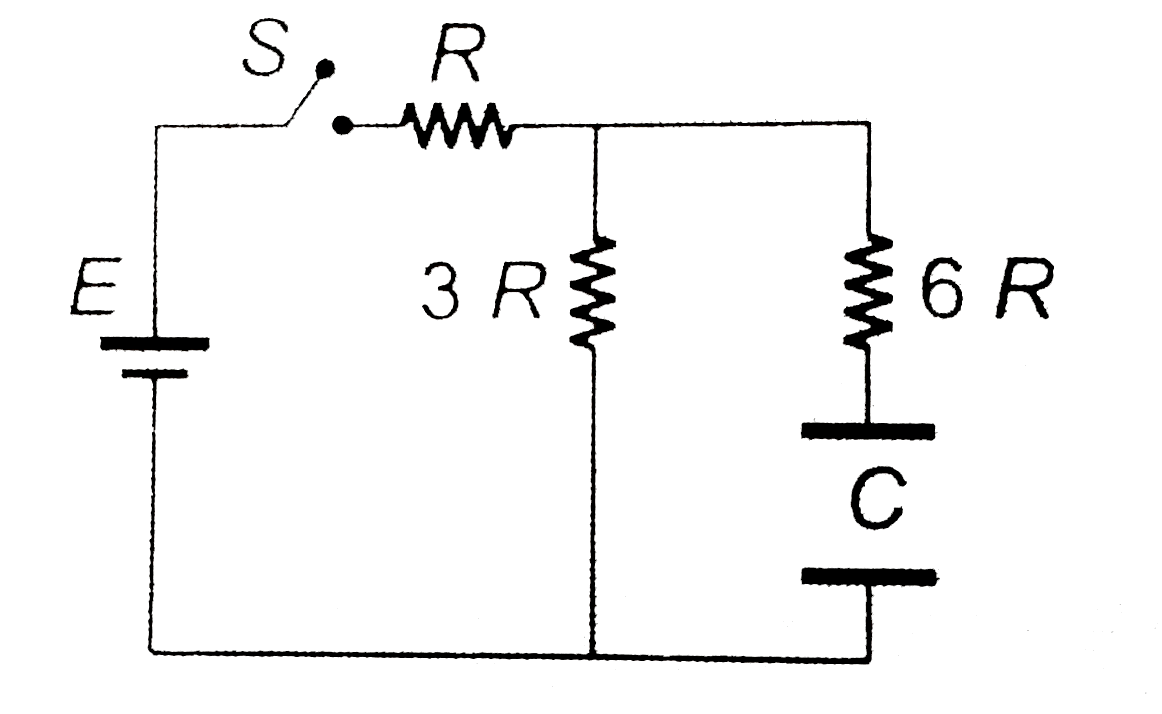
Find currents through resistors
(i) immediately after closing the switch
(ii) after a long time.04:22View Solution
Find (a) equivalent time constant, (b) charge on capacitor in terms of time t.03:50View Solution
At `t=0` switch `S` is closed . Find
`(a) charge on capacitor after one time constant
(b) the time when p.d. across resistance equals p.d. across capacitance
(c ) maximum energy stored in capacitor.06:31View Solution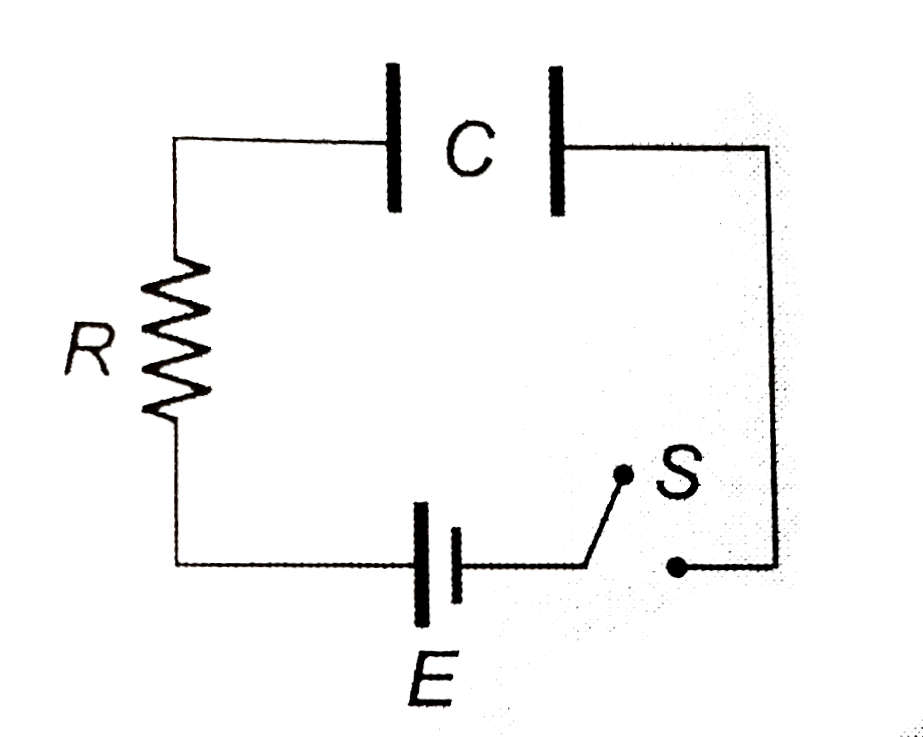
At `t=0` switch `S` is closed .
(a) After how much time , charge on capacitor is 50% of maximum charge stored on capacitor.
(b) After how much time, energy stored in capacitor is halt of maximum energy stored in capacitor.05:50View SolutionConsider the circuits shown in figure. Find
(a)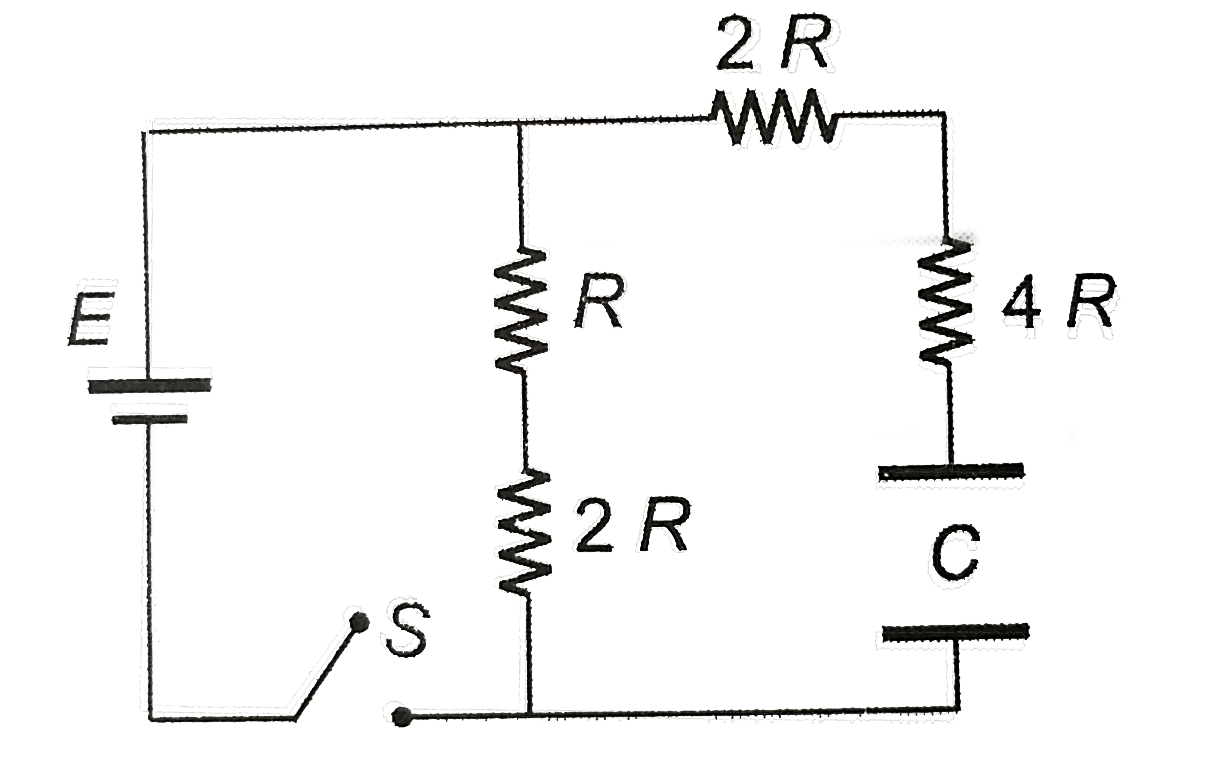
(b)
(c )
(d)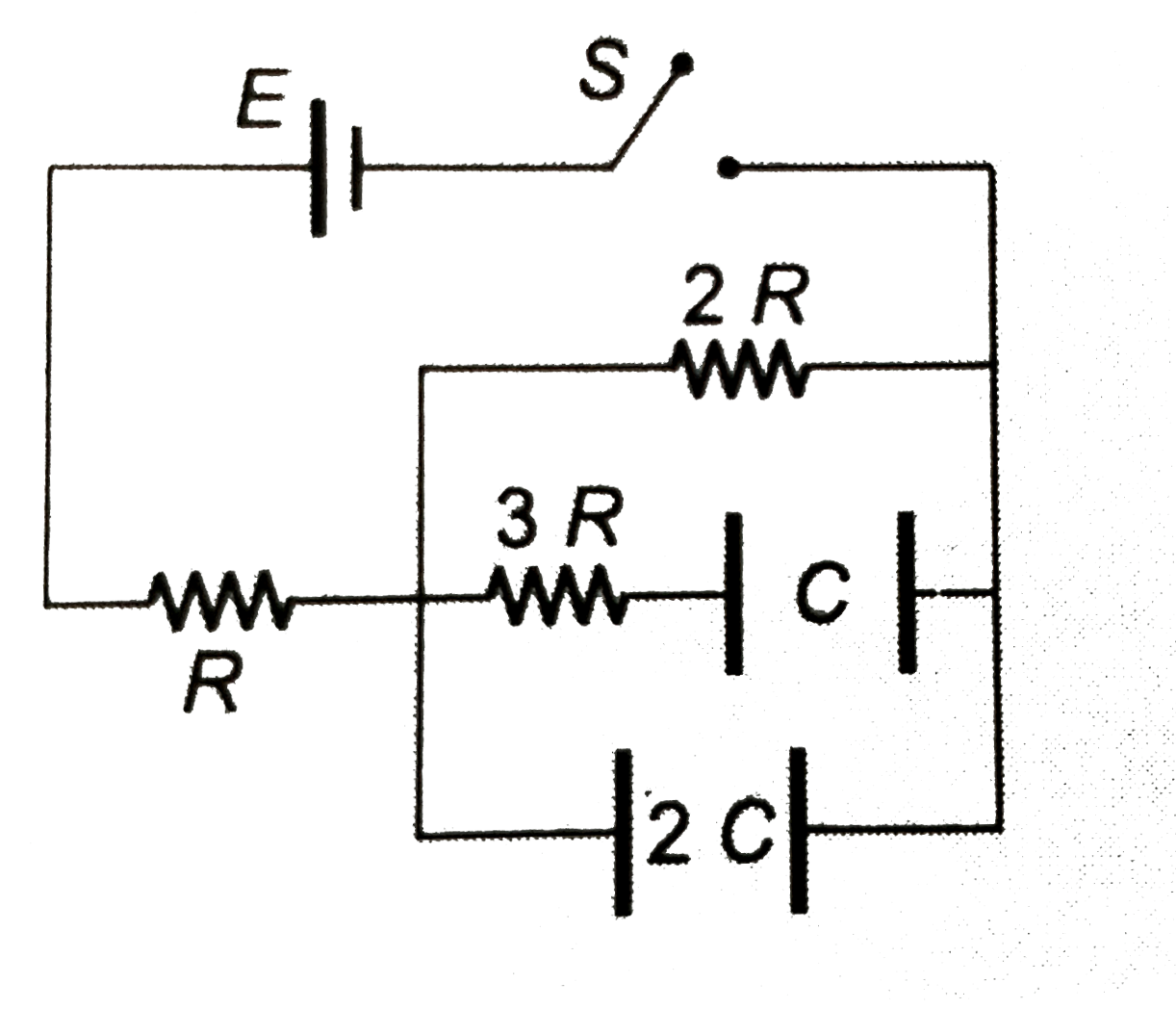
(i) currents through resistances immediately after closing the switch
(ii) Currents through resistaces after a long time ie., steady state.08:53View SolutionFind time constant of the following circuits.
(a)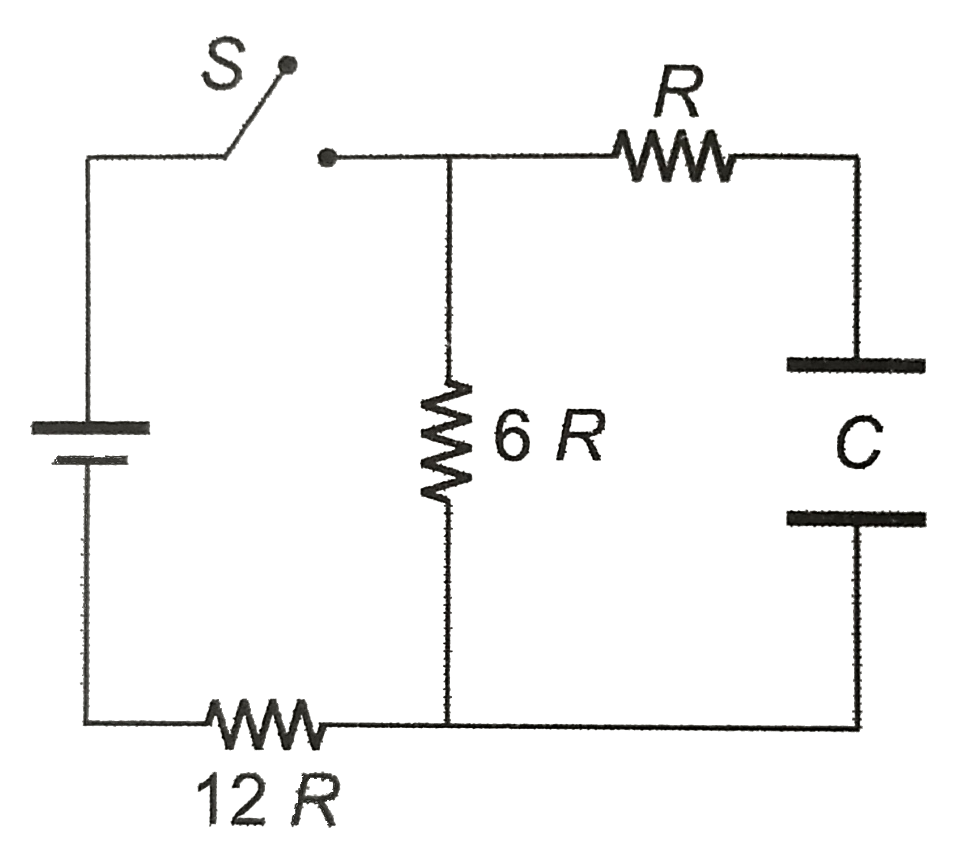
(b)
(c )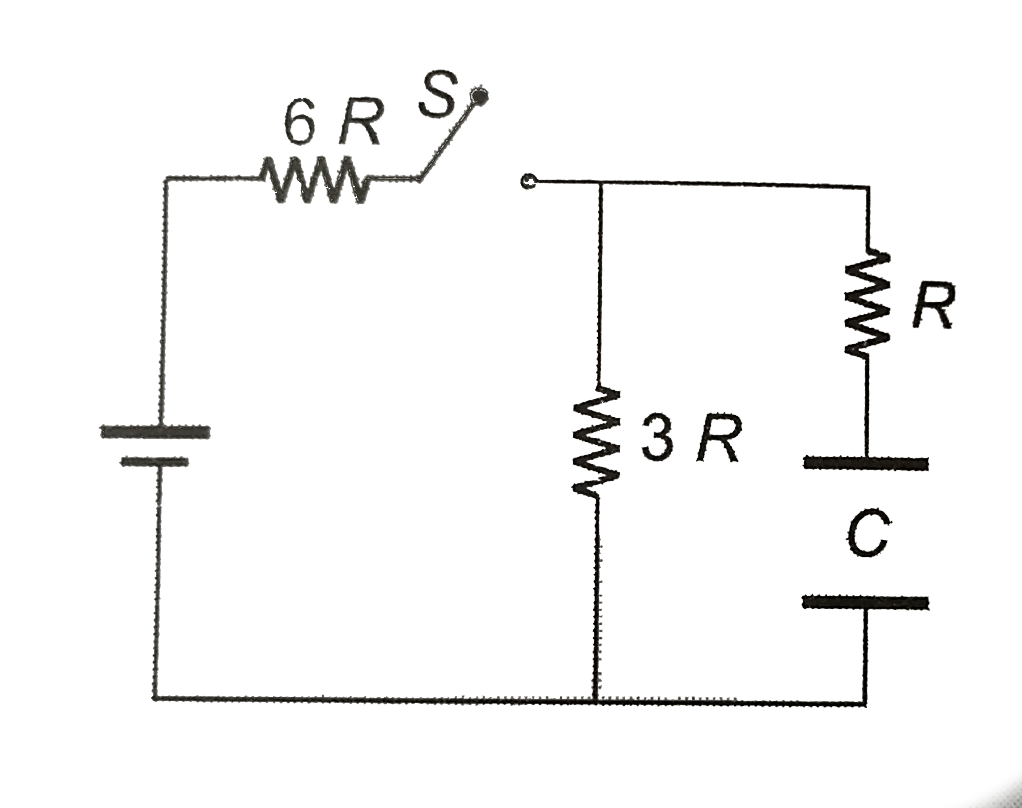
(d)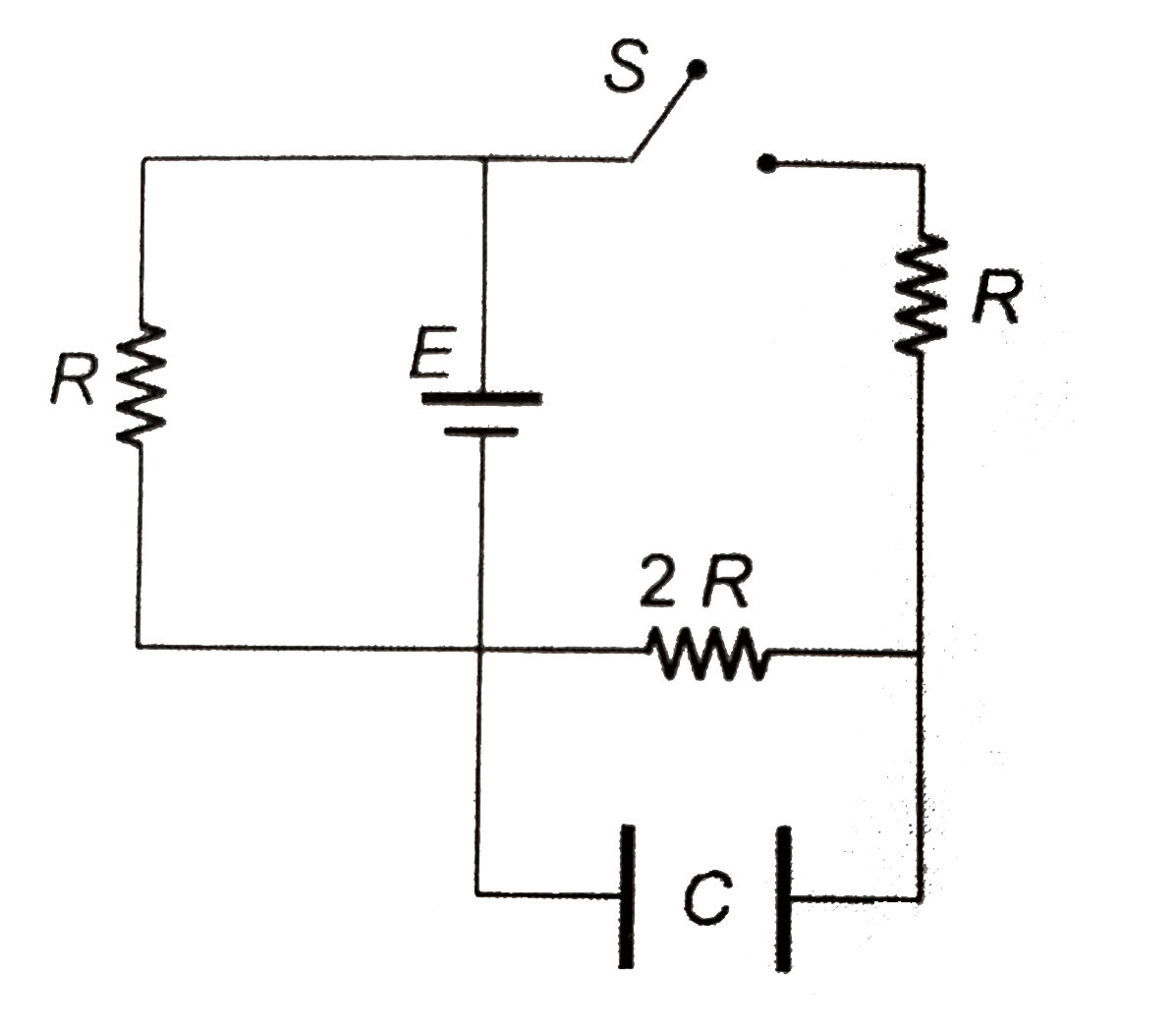 04:37View Solution
04:37View SolutionA capacitance `C`, a resistance `R` and an emf `E` are connected in series at `t=0` what is the maximum value of (a) the potential differnece across the resistor, (b) the current in the circuit , (c ) the power delivered by the battery. (d) the power converted into heat, (e) the potential differnece across the capicitor and (f) the energy stored in the capacitor.
04:12View SolutionHow many time constants will elapse before the charge on a capacitor falls to `0.1%`of its maximum value in a discharging RC circuit.
02:18View SolutionA capacitor charged to `100V` is discharged by connecting the two ptates at `t=0` . If the potential difference across the plates drops to `1.0V` at `10 ms`, what will be the potential difference at `t= 20 ms`.
04:13View SolutionThe switch S shown in figure is kept closed for a long time and is then opened at `t=0`.Find the current in the middle `10(Omega)`resistor at `t=1.0ms`.
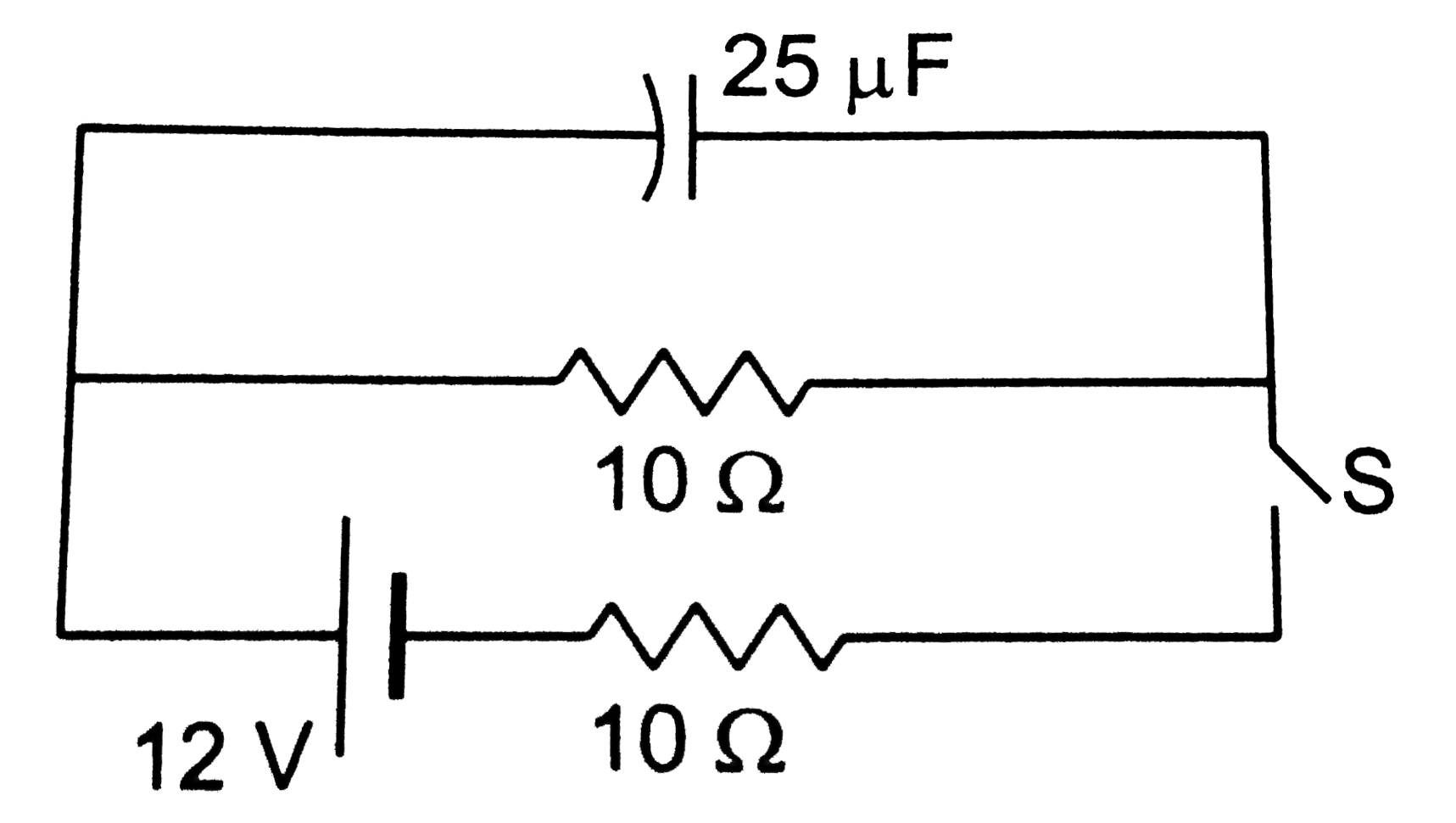 02:08View Solution
02:08View Solution
Examples questions and complete solutions for chapter THERMAL AND ELECTRIC EFFECT oF CURRENT of CP SINGH PHYSICS (HINGLISH) of Class 12
